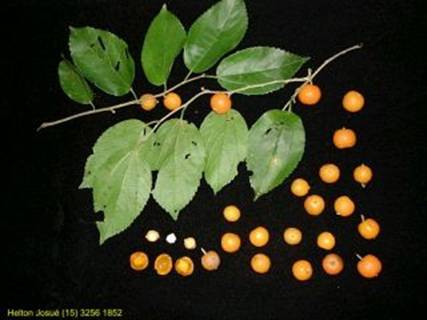CELTIS IGUANEA
COMMON NAMES: Jamerí, Juá-mirim, Gurrupiá
CANNABACEAE

Native Name: Gurrupiá is from the tupi-guarani, will say “Fruit with skin that pops", because one once heard the cracking of the shell of these berries in the beaks of parrots.
Origin: Savannahs, Valley of Rio São Francisco, and in the Pantanal, Brazil.
Features: It is a thorny small tree, sometimes climbing 5 meters high. In the forest it grows up to 10 m tall and has large thorns on old branches and trunks. The leaves are simply bald on top and on the underside sparsely hairy at the bottom and sawed in two colors, therefore the scientific name "iguanaea" for iguana, which means that the color changes. The flowers appear in small clusters or bundles in the leaf axils and are very small and discret.
Planted at Frutas Raras: February 2001, flowered in 2006, fruited in 2007.
Culture tips: Fast growing small tree that prefers red soils and clay soils with rapid water drainage and pH of 5.5, is resistant to freezing to -3°C. Fruits well in full sun or very little in the shade. The fruiting begins 5 to 7 years after planting.
Propagation: Seeds can be stored for 3 months to one year in the refrigerator, germinate within 40 to 90 days in the summer. When the plants reach the size of 30 cm in 4 months after germination, they are very thorny, and must be handled carefully.
Plantation: I recommend a planting in full sun at a distance of 5 x 5 m. The best planting time is from November to January in Brazil, should be waterd every 15 days with liters of water, unles it rains.
Cultivation: The plant grows quickly and requires no special care. For shape cutting the tips of the horizontal branches, which are more than 2 meters long, and erect branches, which are more than 3 meters high, so that the harvest of berries is facilitated. Fertilization with organic compost, it can be chicken manure (8 liters) + 50 grams of NPK 10-10-10, the double amount every year until the third year. The nutrients should be spread in the depth of 5 cm in the circle of 50 cm from the trunk.
Use: The fruit is yellowish, have a crispy shell and are edible, the taste is reminiscent of melons. You can consume it in natura or in the forms of sweets and juices.
Flower Time at Frutas Raras: December to February.
Harvest Time at Frutas Raras: February to May.
BUY THE BOOK “COLECIONANDO FRUTAS”
Back to the seedlist (English) or back to Cannabaceae (Portuguese)